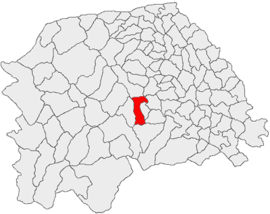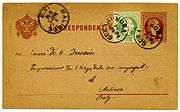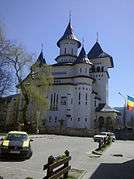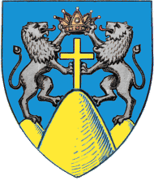Gura Humorului
Gura Humorului (Romanian pronunciation: [ˌɡura huˈmoruluj]; Hebrew and Yiddish: גורה חומורולוי - Gure Humuruluei or גורא הומאָרא - Gura Humora; German and Polish: Gura Humora) is a town in Suceava County, north-eastern Romania. It is situated in the historical region of Bukovina. Gura Humorului is the seventh largest urban settlement in the county, with a population of 12,729 inhabitants, according to the 2011 census. It was declared a town in 1904 and it became a resort in 2005. The town administers the former village of Voroneț (which became a neighborhood), site of Voroneț Monastery.
Gura Humorului | |
|---|---|
 View from Gura Humorului's town center | |
 Coat of arms | |
 Location in Suceava County | |
 Gura Humorului Location in Romania | |
| Coordinates: 47°33′14″N 25°53′21″E | |
| Country | |
| County | Suceava |
| Government | |
| • Mayor | Marius Ioan Ursăciuc[1] (Ind.) |
| Area | 60.90 km2 (23.51 sq mi) |
| Population (2011)[2] | 13,667 |
| • Density | 220/km2 (580/sq mi) |
| Time zone | EET/EEST (UTC+2/+3) |
| Vehicle reg. | SV |
| Website | Official site |
Administration and local politics
Town council
The town's current local council has the following political composition, according to the results of the 2016 Romanian local elections:
| Party | Seats | Current Council | ||||||||||||
|---|---|---|---|---|---|---|---|---|---|---|---|---|---|---|
| National Liberal Party (PNL) | 12 | |||||||||||||
| Social Democratic Party (PSD) | 5 | |||||||||||||
Geography
Gura Humorului is located in the north-eastern part of Romania, in southern Bukovina. The town is situated at the eastern limit of Obicinele Bucovinei mountains, in Humorului Depression, at the confluence of Moldova River and Humor River. The average altitude of the town is 470 meters. The European route E58 and the Suceava - Vatra Dornei railway pass through the town. Suceava, the county capital, is located 34 km away. The town of Frasin is located nearby Gura Humorului (only 7 km away).
Demographics
According to the 1775 Austrian Bukovina census, its population comprised only about 60,000 spread over 10,422 square kilometers. In order to encourage the development of this sparsely-settled land, the authorities subsidized the immigration of colonists to Bukovina. With the end of the first wave of settlement, colonists were to continue arriving at their own expense. As a result of these policies, the census of 1910 showed that the population had risen to over 800,000. People of many different ethnic groups took part in this immigration, including Germans, Rusyns, Hungarians, Ukrainians, Poles, Romanians, and Jews.
| Year | Pop. | ±% |
|---|---|---|
| 1910 | 5,308 | — |
| 1930 | 6,042 | +13.8% |
| 1948 | 4,573 | −24.3% |
| 1956 | 7,216 | +57.8% |
| 1966 | 9,081 | +25.8% |
| 1977 | 13,235 | +45.7% |
| 1992 | 16,629 | +25.6% |
| 2002 | 15,656 | −5.9% |
| 2011 | 12,729 | −18.7% |
| 2016 | 17,047 | +33.9% |
| Source: Austrian and Romanian census data and/or official estimates | ||
In 1992, Gura Humorului had a population of about 17,000 inhabitants were living within the town limits. As of 2016, the town's population surpassed this limit by a very slim margin.[3]
According to the 2011 census data, Gura Humorului had a total population of 12,729 inhabitants: 97.03% were ethnic Romanians, 1.79% Roma, 0.52% Germans (Bukovina Germans), 0.27% Poles, 0.12% Ukrainians, 0.10% Hungarians and 0.07% Russians (including Lipovans).
Gura Humorului is the seventh most populated urban locality in Suceava County and the second most populated locality with the status of town (after Vicovu de Sus).
History

Between 1774 and 1918, Gura Humorului belonged to the Austrian monarchy. During World War I, Bukovina became a battlefield between Austria opposing Russian and Romanian troops. Although the Russians were finally driven out in 1917, defeated Austria would cede the Bukovina province to Romania through the Treaty of Saint-Germain (1919).
Jewish history of Gura Humorului
No Jews lived in Gura Humorului before 1835, when they were allowed to settle, joining other, already represented, ethnic groups (such as Germans from Bohemia, mainly from the Böhmerwald: thirty families settled on the mountainous and densely forested lands nearby the town, establishing a quarter named Bori). The Jewish community began to flourish in 1869, when they formed around a third of the town's population (880 people); the same year, a Beth midrash was established.
A turning point in the town's history was the disastrous fire of May 11, 1899 which destroyed most of the town, more than 400 houses, including many Jewish businesses and homes. It was rebuilt with donations from the United States Jewish communities. The Jewish community in Gura Humorului continued to grow, reaching 1,951 members in 1927.
Jewish cultural life reached its peak in the inter-war period. The languages of choice in city life were Yiddish, German and Romanian. Most of the Jewish community adhered to Orthodox Judaism, and Jewish youngsters studied the Torah along with secular subjects such as geography, history, and mathematics. The community had established Jewish social and political institutions that contributed to all fields of public life.
While persecutions began to increase under the threats posed by Romanian fascist movements such as the Iron Guard, it was World War II that brought an end to Jewish presence in Gura Humorului. Under the dictatorship of Ion Antonescu, Jews were rounded up and deported to Transnistria, where most of them perished – mass murdered through various means, including shootings and criminal negligence (see Holocaust in Romania). Virtually all of the Jewish community in Gura Humorului was deported: 2,945 people were all transported on October 10, 1941.
The vast majority of survivors migrated to Israel in 1947–1951. Statistics show that they numbered below 500 people in all at the time of their departure.
Twin towns – sister cities
Natives
- Andreea Boghian - rower
- Nathan Juran - American film director
- Olha Kobylianska - Ukrainian-German writer
- Viorel Lucaci - rugby player
- Mihai Macovei - rugby player
- Rixi Markus - bridge player
- Vlad Nistor - rugby player
- Daniel Plai - rugby player
- Victor Săhleanu - physician and anthropologist
- Dorin Semeghin - footballer
- Cătălin Țăranu - professional go player (5 Dan)
- Salomon Wininger - biographer
Gallery
.jpg) Panoramic view of the town
Panoramic view of the town6.jpg) The Town Hall
The Town Hall The Town Court
The Town Court School No. 1
School No. 1 School No. 2
School No. 2 Hotel Bucovina
Hotel Bucovina Traditional Romanian wooden house
Traditional Romanian wooden house Olha Kobylianska Statue
Olha Kobylianska Statue The Roman Catholic Church
The Roman Catholic Church The Orthodox Cathedral
The Orthodox Cathedral The Synagogue
The Synagogue
References
- "Results of the 2016 local elections". Central Electoral Bureau. Retrieved 5 April 2020.
- "Populaţia stabilă pe judeţe, municipii, oraşe şi localităti componenete la RPL_2011" (in Romanian). National Institute of Statistics. Retrieved 4 February 2014.
- "Populaţia României pe localitati la 1 ianuarie 2016" (in Romanian). INSSE. 6 June 2016. Archived from the original on 2017-10-27. Retrieved 27 October 2017.
- "Orașul Gura Humorului înfrățit cu localitatea poloneză Puck". Ziare.com. Retrieved April 21, 2020.
- "Decision No 183 on 5 December 2006 by Sulina" (PDF). Archived from the original (PDF) on 1 April 2017. Retrieved 31 March 2017.
External links
| Wikimedia Commons has media related to Gura Humorului. |
| Wikivoyage has a travel guide for Gura Humorului. |
- (in Romanian) Gura Humorului Town Hall official site
- (in Romanian) Gura Humorului touristic site
- (in Romanian) Gura Humorului unofficial site
- (in Romanian) Tourism Guide - Gura Humorului web page
- (in Romanian) Suceava County site - Gura Humorului web page
- (in Romanian) Photo Gallery - Old photos of Gura Humorului
- (in Hebrew) Gura Humorului Jewish Community
- (in Hebrew) Comprehensive lists of Gura Humorului Jews killed in 1941
